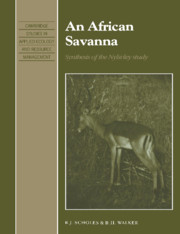Preface
Published online by Cambridge University Press: 06 October 2009
Summary
This book presents the major findings of a sixteen-year study of savanna ecology undertaken at Nylsvley, South Africa. Savannas are a tropical vegetation type in which both trees and grass are an important component. They are the basis of the African livestock industry and their wildlife is a key tourist draw-card. The development of the genus Homo in Africa has largely taken place in savannas, and they are currently home to tens of millions of people. One half of the land surface of Africa is covered by savanna, making it the most extensive African biome. It is also one of the biomes which has received the least ecological study.
Scientists worked in savannas for many years before these became regarded as a distinct biome, rather than a special case of grassland or forest. It became apparent that certain classes of management problem associated with savannas, such as bush encroachment and multispecies herbivory, could not be addressed with conceptual models based on temperate grasslands or tropical forests. One of the results of this realisation was the establishment of the South African Savanna Biome Programme in 1974. The Nylsvley Nature Reserve, 200 km north of Johannesburg, was its principal study site (Figure 0.1).
The aim of the Savanna Biome Programme was to ‘develop the understanding necessary to predict changes in the ecosystem's stability induced by various natural and man-made stresses’ (Anon. 1978).
- Type
- Chapter
- Information
- An African SavannaSynthesis of the Nylsvley Study, pp. ix - xiiPublisher: Cambridge University PressPrint publication year: 1993

